2019 MERCEDES-BENZ AMG GT 4-DOOR COUPE belt
[x] Cancel search: beltPage 42 of 530
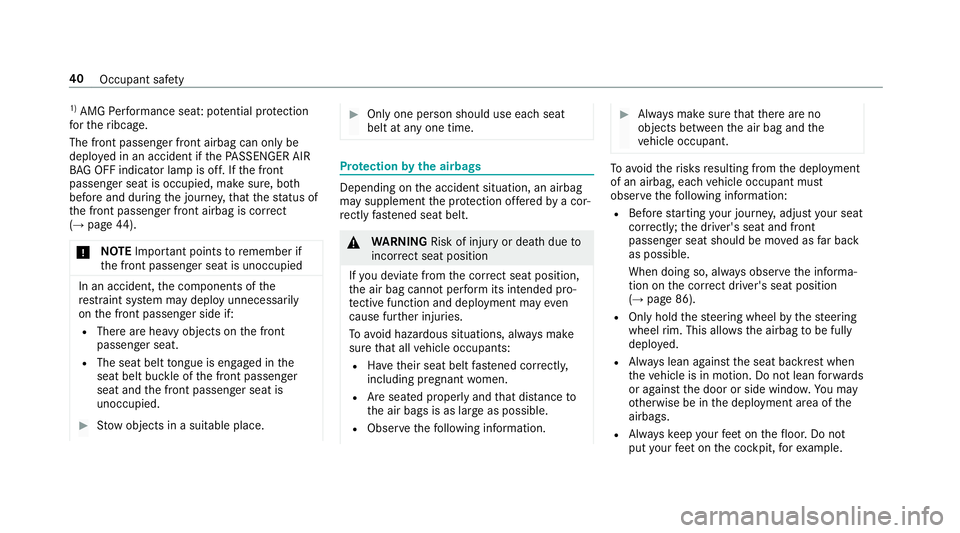
1)
AMG Perfor mance seat:po tentia lpr otect ion
fo rth eribcag e.
The front passeng erfront airbag canonlybe
deplo yedin an acciden tif th ePA SSENGER AIR
BA GOF Find icat orlam pis off.Ifth efront
passeng erseat isoccupied, makesur e,bo th
bef oreand during thejour ney,that thest atus of
th efront passeng erfront airbag iscor rect
(→ page 44).
* NO
TEImpo rtant poin tsto remember if
th efront passeng erseat isunocc upied In
an acciden t,th ecom ponen tsof the
re stra int system maydeplo yunnec essarily
on thefront passeng erside if:
R Ther ear ehea vyobjec tson thefront
passeng erseat.
R The seat belttongu eis eng aged inthe
seat beltbuckleofthefront passeng er
seat andthefront passeng erseat is
unocc upied. #
Stow object sin asuit able place. #
Onlyone person should useeachseat
belt atanyone time. Pr
otection bytheair bags Dep
endingontheacciden tsituation ,an airbag
ma ysupplement thepr otect ion offere dby acor ‐
re ctly fastened seatbelt. &
WARNIN GRisk ofinju ryor deat hdue to
inc orrect sea tpos ition
If yo ude viat efrom thecor rect sea tpos ition,
th eair bag cann otper form itsintended pro‐
te ctiv efuncti onand deployme ntma yev en
cause further injur ies.
To avo idhazar dous situat ions,alw aysmak e
sur eth at all vehicle occupants:
R Have their seat beltfastened correctly ,
incl uding pregna ntwo men.
R Areseat edproper lyand that dis tance to
th eair bags isas larg eas possible.
R Obser vethefo llo wing informatio n. #
Alw aysmak esur eth at ther ear eno
objec tsbetween theair bag and the
ve hicle occupant. To
avo idtherisk sre sulting from thedeplo yment
of an airbag, eachve hicle occupant must
obser vethefo llo wing informatio n:
R Beforest ar tin gyo ur jour ne y,adjus tyo ur seat
co rrect ly;th edr iver's seat andfront
passeng erseat should bemo vedas farbac k
as possi ble.
When doingso,alwaysobser vetheinf orma‐
tion onthecor rect driver's seatpos ition
(→ page 86).
R Onlyhold thesteer ing wheel bythesteer ing
wheel rim. This allow sth eairbag tobe fully
deplo yed.
R Alw ayslean agains tth eseat backres twhen
th eve hicle isin mo tion. Donotlean forw ards
or agains tth edoor orside windo w.Youma y
ot her wise beinthedeplo yment area ofthe
airbag s.
R Alw ayske ep your feet on thefloor .Do not
put your feet on thecoc kpit, forex am ple. 40
Occupan tsaf ety
Page 45 of 530
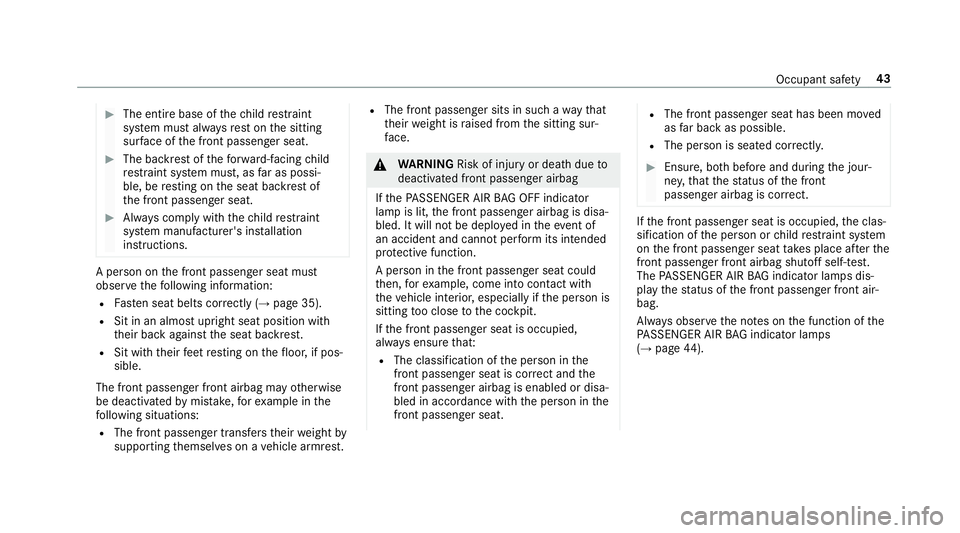
#
The entir ebase ofthech ild restra int
sy stem mus talw aysre st on thesitt ing
sur face ofthefront passeng erseat. #
The backres tof thefo rw ard-f acin gch ild
re stra int system mus t,as faras possi ‐
ble, beresting ontheseat backres tof
th efront passeng erseat. #
Alw ayscom plywit hth ech ild restra int
sy stem manuf acturer'sinstallation
ins truct ions . A
per son onthefront passeng erseat must
obser vethefo llo wing informatio n:
R Fasten seat belts correctl y(→ page 35).
R Sitinan almos tupr ight seatposi tion with
th eir bac kag ains tth eseat backres t.
R Sitwithth eir feet resting onthefloor ,if pos‐
sible.
The front passeng erfront airbag mayot her wise
be deactiv ated bymis take ,fo rex am ple inthe
fo llo wing situat ions:
R The front passen gertr ansf ersth eir weight by
suppor tingthemselv eson ave hicle armr est. R
The front passeng ersits insuc hawa yth at
th eir weight israised from thesitt ing sur‐
fa ce. &
WARNIN GRisk ofinju ryor deat hdue to
deactiv ated front passeng erairbag
If th ePA SSENGER AIRBAGOF Find icat or
lam pis lit,th efront passeng erairbag isdisa‐
bled. Itwill notbe deplo yedin theeve ntof
an acci dent and canno tpe rfor m its intended
pr otect ive func tion.
A per son inthefront passeng erseat could
th en, forex am ple, com eint ocon tact with
th eve hicle interior ,especially ifth eper son is
sitt ing tooclose tothecoc kpit.
If th efront passeng erseat isoccupied,
alw aysensur eth at:
R The classificat ion oftheper son inthe
fr ont passeng ersea tis cor rect and the
fr ont passeng erairb agisenabl edordisa ‐
ble din accor dance withth eper son inthe
fr ont passeng ersea t. R
The front passeng ersea thas been moved
as farbac kas possi ble.
R The person isseat edcor rectl y. #
Ensu re,bo th bef oreand during thejour‐
ne y,that thest atus ofthefront
passeng erairbag iscor rect. If
th efront passeng erseat isoccupied, theclas‐
sif ication oftheper son orchild restra int system
on thefront passeng erseat take splace afte rth e
fr ont passeng erfront airbagshut offself-t est.
The PASSENGER AIRBAGind icat orlam psdis‐
pla yth est atus ofthefront passeng erfront air‐
bag.
Alw aysobser vetheno teson thefunc tion ofthe
PA SSENGER AIRBAGind icat orlam ps
(→ pag e44 ). Occ
upant safety 43
Page 47 of 530
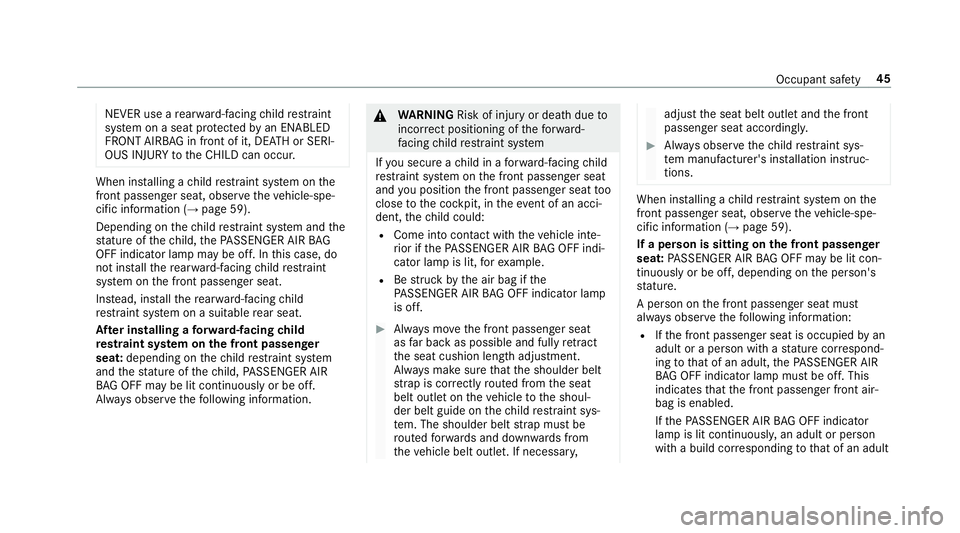
NEVER
useare ar wa rd-faci ng child restra int
sy stem onaseat protect edbyan ENABLED
FR ONT AIRB AG infront ofit,DE ATHor SERI‐
OUS INJURYtotheCH ILD can occur . When
installing ach ild restra int system onthe
fr ont passeng ersea t,obse rveth eve hicle-spe‐
cif icinf ormation (→pag e59).
Depending onthech ild restra int system and the
st atur eof thech ild, thePA SSENGER AIRBAG
OFF indicat orlam pma ybe off.In this case, do
no tins tallth ere ar wa rd-faci ng child restra int
sy stem onthefront passeng erseat.
Ins tead, installth ere ar wa rd-faci ng child
re stra int system onasuit able rear seat .
Af terin st alli ng afo rw ard-f acin gch ild
re stra int system onthefront passeng er
seat :depen dingonthech ild restra int system
and thest atur eof thech ild, PASSENGER AIR
BA GOF Fma ybe litcon tinuousl yor be off.
Alw aysobser vethefo llo wing informatio n. &
WARNIN GRisk ofinju ryor deat hdue to
inc orrect pos itioning ofthefo rw ard-
fa cing child restra int system
If yo usec ureach ild inafo rw ard-f acin gch ild
re stra int system onthefront passeng erseat
and youposi tionth efront passeng erseat too
clos eto thecoc kpit, intheeve ntofan acci ‐
de nt, thech ild could:
R Come intocon tact with theve hicle inte‐
ri or ifth ePA SSENGER AIRBAGOF Find i‐
cat orlam pis lit,fo rex am ple.
R Bestru ck bytheair bag ifth e
PA SSENGER AIRBAGOF Find icat orlam p
is off. #
Alw aysmo vethefront passeng erseat
as farbac kas possi bleand fully retract
th eseat cushion lengthadjus tment.
Alw aysmak esur eth at theshoulder belt
st ra pis cor rectly routed from theseat
belt outle ton theve hicle totheshoul‐
der belt guide onthech ild restra int sys‐
te m. The shou lderbeltstra pmus tbe
ro uted forw ards and down wardsfrom
th eve hicle beltoutle t.Ifnecessar y, adjus
tth eseat beltoutle tand thefront
passeng erseat accor dingly. #
Alw aysobser vethech ild restra int sys‐
te m manuf acturer'sinstallation instruc‐
tion s. When
installing ach ild restra int system onthe
fr ont passeng ersea t,obse rveth eve hicle-spe‐
cif icinf ormation (→pag e59).
If aper son issitting onthefront passeng er
seat :PA SSENGER AIRBAGOF Fma ybe litcon ‐
tin uousl yor be off,depen dingon theper son's
st atur e.
A per son onthefront passeng erseat must
alw aysobser vethefo llo wing informatio n:
R Ifth efront passeng erseat isoccupied byan
adult oraper son withast atur ecor respond‐
ing tothat ofan adult ,th ePA SSENGER AIR
BA GOF Find icat orlam pmus tbe off.This
ind icat esthat thefront passeng erfront air‐
bag isenabled.
If th ePA SSENGER AIRBAGOF Find icat or
lam pis lit con tinuousl y,an adult orper son
wit habuild corresponding tothat ofan adult Oc
cupan tsaf ety 45
Page 48 of 530
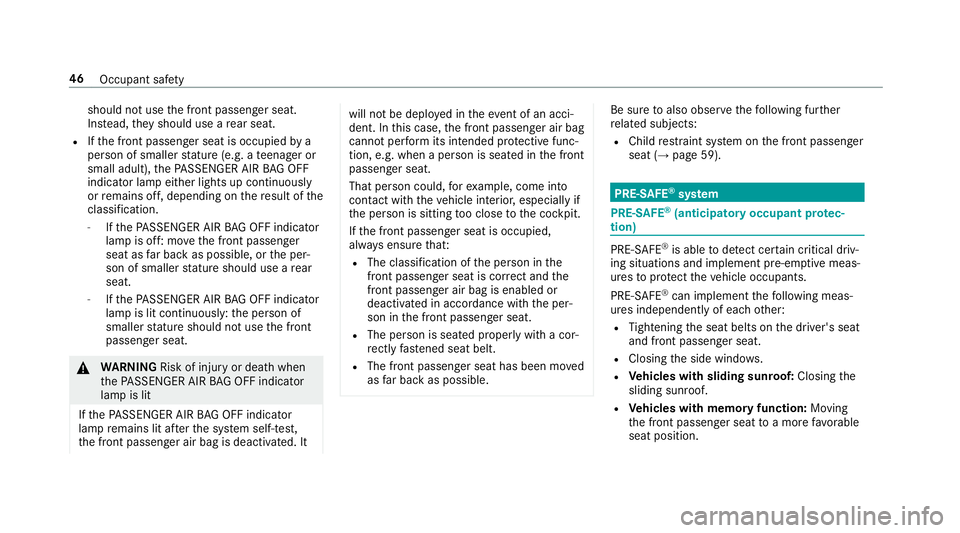
should
notuse thefront passeng erseat.
Ins tead, they should useare ar seat .
R Ifth efront passeng erseat isoccupied bya
per son ofsmaller statur e(e. g.ate enag eror
small adult), thePA SSENGER AIRBAGOF F
ind icat orlam peit her light sup con tinuousl y
or remains off,depe nding onthere sult ofthe
cla ssificati on.
- Ifth ePA SSENGER AIRBAGOF Find icat or
lam pis off:mo vethefront passeng er
seat asfarbac kas possi ble,ortheper‐
son ofsmaller statur eshoul duse are ar
seat .
- Ifth ePA SSENGER AIRBAGOF Find icat or
lam pis lit con tinuousl y:theper son of
smaller statur eshoul dno tuse thefront
passeng erseat. &
WARNIN GRisk ofinju ryor deat hwhen
th ePA SSENGER AIRBAGOF Find icat or
lam pis lit
If th ePA SSENGER AIRBAGOF Find icat or
lam pre mains litafte rth esy stem self-t est,
th efront passeng erair bag isdeactiv ated. It will
notbe deplo yedin theeve ntofan acci ‐
de nt. Inthis case, thefront passeng erair bag
cann otper form itsintended protect ive func ‐
tion ,e.g. when aper son isseat edinthefront
passeng erseat.
That person could, forex am ple, com eint o
con tact with theve hicle interior ,especially if
th eper son issitt ing tooclose tothecoc kpit.
If th efront passeng erseat isoccupied,
alw aysensur eth at:
R The classificat ion oftheper son inthe
fr ont passeng ersea tis cor rect and the
fr ont passeng erair bag isenabl edor
dea ctivated inaccor dance withth eper‐
son inthefront passeng erseat.
R The person isseat edproper lywit hacor‐
re ctl yfa stened seatbelt.
R The front passeng erseat hasbeen moved
as farbac kas possi ble. Be
sureto also obse rveth efo llo wing further
re lat ed subje cts:
R Child restra int system onthefront passeng er
seat (→pag e59). PRE-S
AFE®
sy stem PRE-
SAFE®
(ant icipa tory occupa ntprotec‐
tion) PRE-
SAFE®
is ab leto detect cer tain critic aldriv‐
ing situat ionsandimplemen tpr e-em ptive meas‐
ur es toprotect theve hicle occupants.
PRE-S AFE®
can implement thefo llo wing meas‐
ur es indepe ndently of eac hot her :
R Tight ening theseat belts onthedr iver's seat
and front passeng erseat.
R Closing theside windo ws.
R Vehicl eswith sliding sunroof:Clo sing the
sliding sunroof.
R Vehicl eswith memor yfuncti on:Moving
th efront passeng erseat toamor efa vo rable
seat position . 46
Occupant safety
Page 49 of 530

R
Vehicl eswith multico ntour seat :Incr eas‐
ing theair pressur ein theseat sidebolsters
of theseat backres t.
R PRE-S AFE®
Sound: prov ided that themulti‐
media system isswitc hedon,gener ates a
br iefnoi sesigna lto stimulat eth einnat epr o‐
te ctiv emec hanism ofaper son's hearing.
* NO
TEDama gecau sed byobject sin the
fo ot we llor behin dth eseat The
automatic adjustmentof theseat posi‐
tion mayre sult indamag eto theseat and/or
th eobjec t. #
Stow object sin asuit able place. Re
versing thePRE- SAFE®
sy stem mea sures If
an acc iden tdid notocc ur,th epr e-em ptive
measur esthat we retak en arere ve rsed.
Yo uwill need toper form certainse ttings your‐
self . #
Ifth eseat beltpre-t ension ingisno tre duced,
mo vetheseat backres tbac kslightl y.
The locking mechanism releases. Fu
nction ofPRE-S AFE®
PL US (anticipat ory
occupant protection plus) PRE-
SAFE®
PL US can detect cer tain im pact s,
par ticular lyan imm inentrear impact ,and take
pr e-em ptive measur estoprotect theve hicle
occupants. Thesemeasur escanno tnecessar ily
pr eve ntan imm inentimpact.
PR E-S AFE ®
PL US can implem entthefo llo wing
measur esindepe ndently of eac hot her :
R Tight ening theseat belts onthedr iver's seat
and front passeng erseat.
R Increasin gbr ak epr essur ewhen theve hicle
is statio nary.This brak eapplication iscan‐
celed automaticall ywhen theve hicle pulls
aw ay.
If an accident didnotoccur ,th epr e-em ptive
measur esthat we retake nar ere ve rsed. Sy
stem limita tions
The system will notinitiat ean yaction inthefo l‐
lo wing situat ions:
R when backingup
The system will notinitiat ean ybr aking applica‐
tion inthefo llo wing situat ions:
R whils tdr ivin g
or
R when entering orexitin gapar kingspace
while using ActivePa rking Assist Inf
orma tion onPRE- SAFE®
Im pulse Side If
an imm inentside impact isde tected, PRE-
SA FE®
Im pulse Side canpre-emp tively movethe
fr ont seatve hicle occupant's upperbody
to wa rdsth ecent eroftheve hicle. Itdoes this by
ra pidl yinf lating anair cushion intheout erseat
side bolsterof theseat backres ton theside on
whic hth eim pact isantic ipated.This increases
th edis tan cebetween thedoor andtheve hicle
occupant. Occupant
safety 47
Page 50 of 530
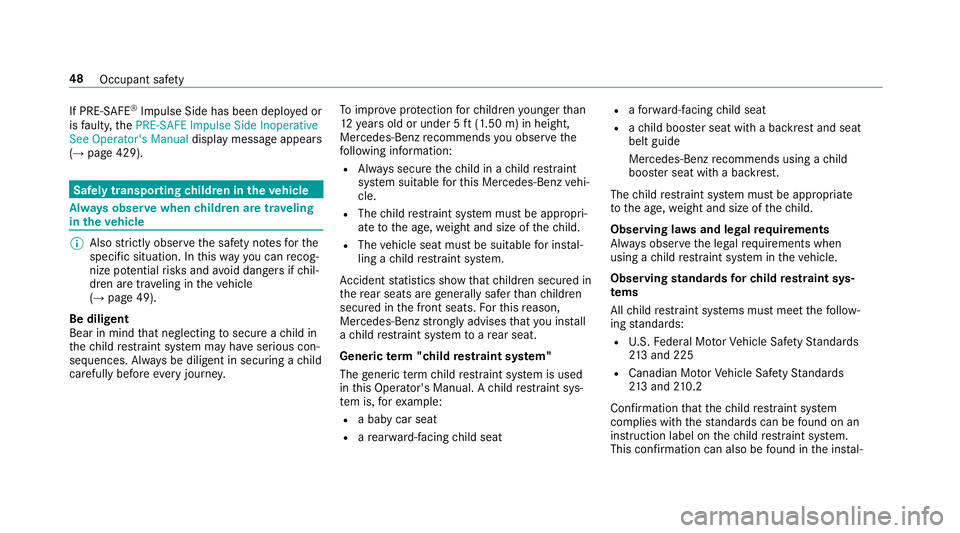
If
PRE-S AFE®
Im pul seSide hasbeen deployed or
is faulty ,th ePRE-S AFEImpulse SideInoper ative
See Operator 'sManual displaymessag eappear s
(→ pag e429). Saf
elytranspor tingchildr enintheve hicl e Alw
aysobser vewhen childr enaretrave ling
in theve hicl e %
Also strictly observe thesaf etyno tesfo rth e
specif icsituation. Inthis wa yyo ucan recog‐
nize potentia lri sk sand avoiddang ersif ch il‐
dr en aretrav eling intheve hicle
(→ pag e49).
Be dilig ent
Bear inmind that neg lectingto secur each ild in
th ech ild restra int system mayha ve ser ious con‐
seq uences. Alwaysbe dilig entinsecur ingach ild
car efull ybef oreeve ryjou rney . To
improve protect ion forch ildr enyoung erthan
12 yearsold orunde r5 ft (1.50 m)inheight ,
Mer cedes- Benzre comme ndsyouobse rveth e
fo llo wing informatio n:
R Alw ayssecur eth ech ild inach ild restra int
sy stem suitable forth is Mer cedes -Benz vehi‐
cle.
R The child restra int system mus tbe appr opri‐
at eto theag e, we ight andsize ofthech ild.
R The vehicle seatmustbe suit able forins tal‐
ling ach ild restra int system.
Ac cid ent statis ticssho wthat childr ensecur edin
th ere ar seat sar ege ner ally sa ferth an childr en
secur edinthefront seats. Forth is reason ,
Mer cedes-Ben zst ro ng lyad vis es that youins tall
a ch ild restra int system toare ar seat .
Gener icterm "child restra int system"
The gener icterm child restra int system isused
in this Oper ator's Manual. Ach ild restra int sys‐
te m is, forex am ple:
R abab ycar seat
R are ar wa rd-faci ng child seat R
afo rw ard-f acin gch ild seat
R ach ild boos terseat withabac kres tand seat
belt guide
Mer cedes-Benz recomme ndsusing ach ild
boos terseat withabac kres t.
The child restra int system mus tbe appr opriate
to theag e, we ight andsize ofthech ild.
Obser vinglaws and legalrequ irement s
Alw aysobser vetheleg alrequ iremen tswhen
using ach ild restra int system intheve hicle.
Obser vingstandar dsforch ild restra int sys‐
te ms
All child restra int systems mustmee tth efo llo w‐
ing standar ds:
R U.S. Feder alMo torVe hicle SafetySt andar ds
21 3and 225
R Canadi anMo torVe hicle SafetySt andar ds
21 3and 210.2
Conf irmatio nth at thech ild restra int system
com plies withth est andar dscan befound onan
ins truct ion label onthech ild restra int system.
This confirm atio ncan also befound intheins tal‐ 48
Occupant safety
Page 51 of 530
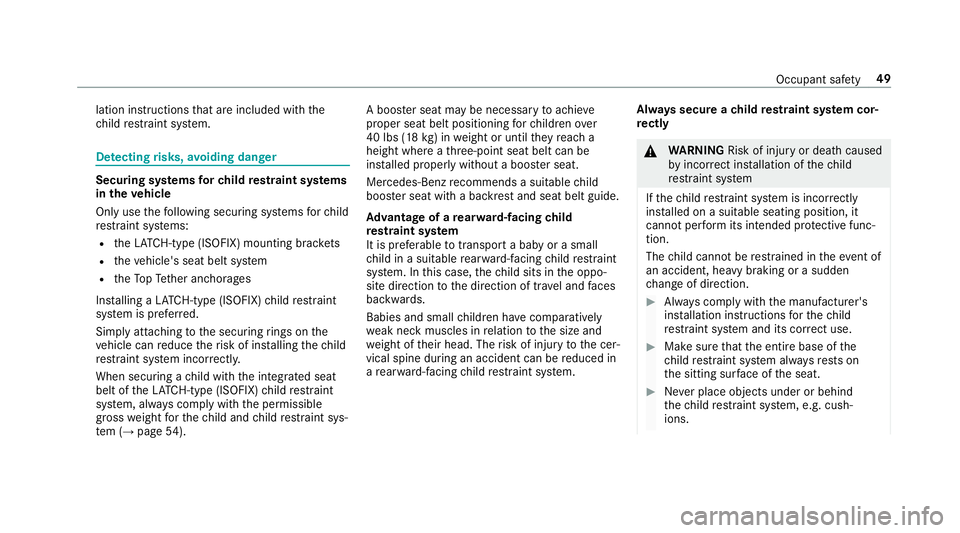
lation
instruct ions that areinc luded withth e
ch ild restra int system. De
tectin grisk s,avo iding danger Secur
ingsystems forch ild restra int systems
in theve hicl e
Only usethefo llo wing secur ingsystems forch ild
re stra int systems:
R theLA TC H-type (ISOFIX )mou nting brac kets
R theve hicle's seatbeltsystem
R theTo pTe ther anc horages
Ins talling aLA TC H-type (ISOFIX )ch ild restra int
sy stem isprefer red.
Sim plyattaching tothesecur ingrings onthe
ve hicle canreduce therisk ofins talling thech ild
re stra int system incor rectly .
Whe nsecu ring ach ild withth eint egr ated seat
belt oftheLA TC H-type (ISOFIX )ch ild restra int
sy stem, alwayscom plywit hth eper missible
gr oss weight forth ech ild and child restra int sys‐
te m (→ pag e54 ). A
boos terseat maybe necessar yto achie ve
pr oper seatbeltposition ingforch ildr enove r
40 lbs (18 kg )in we ight orunt ilth ey reac ha
heigh twher eath re e-point seatbeltcanbe
ins talled proper lywit hout aboos terseat.
Mer cedes-Benz recomme ndsasu itab lech ild
boos terseat withabac kres tand seat beltguide.
Ad vantag eof are ar wa rd-faci ng child
re stra int system
It is prefer able totrans portabab yor asmall
ch ild inasuit able rear wa rd-faci ng child restra int
sy stem. Inthis case, thech ild sits intheoppo‐
sit edir ect ion tothedir ect ion oftra veland faces
ba ckwa rds.
Babies andsmall childr enhave com parativ ely
we ak nec kmusc lesinrelation tothesize and
we ight oftheir head. Therisk ofinjur yto thecer‐
vical spine during anacciden tcan bereduced in
a re ar wa rd-faci ng child restra int system. Alw
ayssecur each ild restra int system cor‐
re ctl y &
WARNIN GRisk ofinju ryor deat hcaused
by inc orrect ins tallation ofthech ild
re stra int system
If th ech ild restra int system isincor rectly
ins talled onasuit able seatin gposit ion,it
can notper form itsintended protect ive func ‐
tion .
The child can notbe restra ined intheev ent of
an acciden t,hea vybraking orasudden
ch ang eof dir ect ion. #
Alw ayscom plywit hth emanuf acturer's
ins tallation instruct ions forth ech ild
re stra int system and itscor rect use. #
Makesur eth at theent ire base ofthe
ch ild restra int system alwaysre stson
th esitt ing surface oftheseat. #
Neverpla ceobjects underorbehi nd
th ech ild restra int system, e.g.cush‐
ions. Occ
upant safety 49
Page 52 of 530
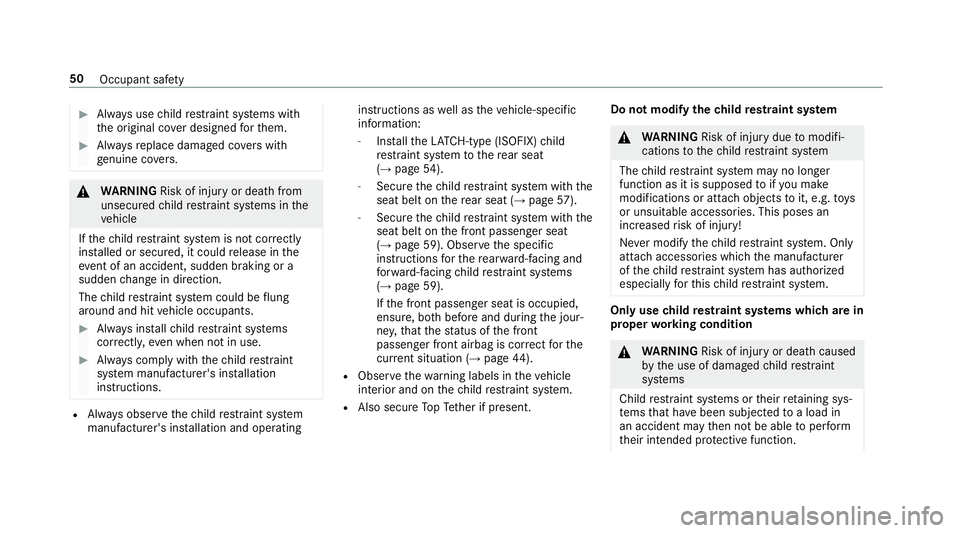
#
Alw aysuse child restra int systems with
th eor iginal coverdesi gned forth em. #
Alw aysre place damag edcovers wit h
ge nui ne covers. &
WARNIN GRisk ofinju ryor deat hfrom
unsecur edchild restra int systems inthe
ve hicle
If th ech ild restra int system isno tcor rectly
ins talled orsecur ed,itcould release inthe
ev ent ofan acciden t,sudden braking ora
sudden chang ein dir ect ion.
The child restra int system could beflung
ar oun dand hitvehicle occupants. #
Alw aysins tallch ild restra int systems
cor rectl y,eve nwh en notin use. #
Alw ayscom plywit hth ech ild restra int
sy stem manuf acturer'sinstallation
ins truct ions . R
Alw aysobser vethech ild restra int system
manuf acturer'sinstallation andopera ting ins
truct ions aswellas theve hicle-specif ic
inf ormation:
- Installth eLA TC H-type (ISOFIX )ch ild
re stra int system tothere ar seat
(→ pag e54 ).
- Sec ureth ech ild restra int system withth e
seat beltonthere ar seat (→pag e57 ).
- Sec ureth ech ild restra int system withth e
seat beltonthefront passeng erseat
(→ pag e59). Obser vethespecif ic
ins truction sfo rth ere ar wa rd-faci ng and
fo rw ard-f acin gch ild restra int systems
(→ pag e59).
If th efront passeng erseat isoccupied,
ensur e,bo th bef oreand during thejour‐
ne y,that thest atus ofthefront
passeng erfront airbag iscor rect forth e
cur rent situa tion(→ page 44).
R Obser vethewa rning labels intheve hicle
int erior and onthech ild restra int system.
R Also secur eTo pTe ther ifpr esent . Do
notmodif yth ech ild restra int system &
WARNIN GRisk ofinju rydue tomodif i‐
cations tothech ild restra int system
The child restra int system mayno long er
func tion asitis supposed toifyo umak e
mod ificat ionsor att achobj ect sto it,e.g. toys
or unsuit ableaccessor ies.This poses an
incr eased risk ofinjur y!
Ne vermodify thech ild restra int system. Only
att achaccessor ieswhic hth emanuf acturer
of thech ild restra int system has author ized
especially forth is ch ild restra int system. Onl
yuse child restra int systems whichar ein
pr oper working condit ion &
WARNIN GRisk ofinju ryor deat hcaused
by theuse ofdamag edchild restra int
sy stems
Child restra int systems ortheir retainin gsy s‐
te ms that have been subjec tedto aload in
an acc iden tma yth en notbe able toper form
th eir intended protect ive func tion. 50
Occupant safety